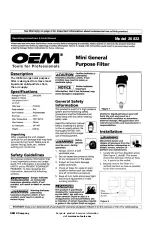
2
Introduction
Thank you for your purchase of a state of the art Watts Reverse
Osmosis (RO) water treatment system.
Water quality concerns are
becoming more of a focus for the public . You may have heard about
contaminants in the drinking water, such as Arsenic, Chromium,
Cryptosporidium or Giardia . There may also be some local water
issues such as high levels of Lead and Copper . This Watts water
treatment system has been designed and tested to provide you with
high quality drinking water for years to come . The following is a brief
overview of the system .
Your Reverse Osmosis System:
Osmosis is the process of water passing through a semi-permeable
membrane in order to balance the concentration of contaminants
on each side of the membrane . A semi-permeable membrane is a
barrier that will pass some particles like clean drinking water, but not
other particles like arsenic and lead .
Reverse osmosis uses a semi-permeable membrane; however, by
applying pressure across the membrane, it concentrates contami-
nants (like a strainer) on one side of the membrane, producing crystal
clear water on the other . This is why RO systems produce both clean
drinking water and waste water that is flushed from the system . This
reverse osmosis system also utilizes carbon block filtration technol-
ogy and can, therefore, provide a higher quality drinking water than
carbon filtration systems alone .
Your system is a 4-Stage RO which is based upon separate treat-
ment segments within the one complete water filtration system .
These stages are as follows:
Stage 1 – Sediment filter, recommended change 6 months.
(See Page 8).
The first stage of your RO system is a five-micron sedi-
ment filter that traps sediment and other particulate matter
like dirt, silt and rust which affect the taste and appear-
ance of your water .
Stage 2 –
Carbon filter, recommended change 6 months.
(See Page 8).
The second stage contains a five-micron carbon block
filter . This helps ensure that chlorine and other materials
that cause bad taste and odor are greatly reduced .
Stage 3 -
Membrane, recommended change 2-5 years.
Stage 3 is the heart of the reverse osmosis system, the
RO membrane . This semi-permeable membrane will ef-
fectively take out TDS, Sodium and heavy metals such as
arsenic, copper, and lead, as well as Cysts, such as Giar-
dia and cryptosporidium . Because the process of making
this high quality drinking water takes time, your RO water
treatment system is equipped with a storage tank .
Stage 4 - GAC filter, recommend change 6 - 12 months.
The final stage is a granular activated carbon (GAC) filter .
This filter is used after the water storage tank and is used
as a final polishing filter .
Note: Filter & Membrane life may vary based upon local water
conditions and/or use patterns.
System Maintenance
Just because you cannot taste it, does not mean that it is not there .
Contaminants such as lead, chromium and arsenic (to name a few)
are undetectable to the taste . Additionally, over time if you do not
replace the filter element, other bad tastes and odors will be appar-
ent in your drinking water .
This is why it is important to change out your filter at the recom-
mended intervals as indicated in this system manual . When replacing
the filter elements, pay special attention to any cleaning instructions .
Should you have any further questions please refer to our website
at
www.watts.com
or call our customer service department at
1-800-244-1299.
With proper installation and maintenance, this system will provide
you with high quality water for years to come . All of Watts water
enhancement products are rigorously tested by independent labora-
tories for safety and reliability . If you have any questions or concerns,
please contact our Customer Service department at 1-800-244-
1299 or refer to our on-line troubleshooting at www .watts .com .
Replacement Filter Pack
Model
Frequency
description
PWFIL-2PACK-KC-KC4
6 Months
Includes sediment and pre-carbon filters only
PWFIL-4PACK-KC-KC4
Annual
Includes all filters and membrane
PWFIL-MEM-KC-60GPD
2 - 5 years
60 gallon per day membrane
PWFIL-GAC-KC-13
Annually
GAC final filter
note:
Water conditions may require more frequent cartridge replacement.






























